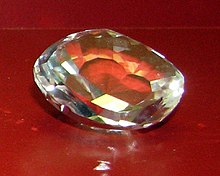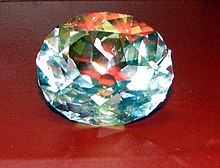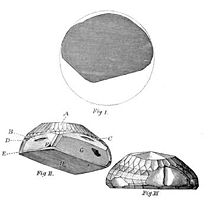Koh-i-Noor
The Koh-i-Noor ( Persian كوه نور, DMG Kūh-e Nūr or Kōh-i Nūr , "Mountain of Light") is a 108.93- carat diamond (21.786 g). It is considered to be one of the largest diamonds in the world and is now part of the British Crown Jewels in the Tower of London , where it is also on display. Mainly due to its seemingly adventurous history, it is one of the most famous diamonds today.
Legend
Allegedly, the Koh-i-Noor is the diamond still in existence whose whereabouts can be traced the longest. The oldest myth is said to be over 5000 years old when a great jewel was mentioned in a Sanskrit epic. Hindu gods also quarreled, according to Indian mythology, over a great jewel. Whether the Koh-i-Noor is one of these old stones can no longer be traced today. It is believed that it originated in the old Indian diamond mining area of Kollur in the Guntur district near Golkonda .
history
The stone was first mentioned in 1304 when the Sultan Ala ud-Din Khalji stole it from the Khan of Malwa ( Afghanistan ). The stone then adorned the peacock's eye in the then world-famous magnificent peacock throne in Delhi . Over the centuries, the diamond changed hands several times, mostly to Persians, Indians and Afghans. During the conquest of Delhi in 1739, it fell into the hands of Nadir Shah of Persia . The legend tells that a harem lady told the Conqueror that the diamond in the turban of the Moguls was hidden. The Shah then proposed to the Mughal at a ceremony that they exchange turbans. This gesture was seen as a symbol of eternal friendship and brotherhood, and to reject it would have been an affront. When the Shah was wrapping the diamond out of the cloth, he is said to have called Koh-i-Noor for joy .
In 1747 the Persian Shah was assassinated and the Koh-i-Noor went to the treasury of Punjab . When the state was annexed by British India in 1849 , the treasure became the property of the British East India Company as a result of the Sikh Wars .
In 1850 the stone was presented to the British Queen Victoria on the 250th anniversary of the founding of the British East India Company. Queen Victoria had the Koh-i-Noor re-sharpened after astonishment at its lack of fire had risen. The previously 186-carat diamond was brought to its current size of 108.93 carats (21.786 g).
For the coronation of Queen Mary in 1911, the Koh-i-Noor was used as the central stone of the crown and finally in 1937 in the crown of Queen Elizabeth , who later became Queen Mother.
The Koh-i-Noor can be visited together with the British Crown Jewels in the Tower of London .
Dispute over property rights
In Pakistan , Afghanistan and Iran there have been repeated calls for the return of the Koh-i-Noor in the past. More recently, the question has been discussed whether the family of the former Maharajah of Punjab, Ranjit Singh , who acquired the diamond in 1747, voluntarily handed the stone over to the British in the 19th century. In March 2016, India's Supreme Court in Delhi examined a petition for the diamond to be returned. On April 18, 2016, the Indian Attorney General Ranjit Kumar declared the dispute over for the time being. The attorney general stated that the stone had not been stolen or stolen by the colonial power Great Britain. The Indian Ministry of Culture then announced that India would try to win back the diamond in a friendly way.
See also
literature
- Franz Littich: Historical diamonds and their history. Rühle-Diebener-Verlag, Stuttgart 1982.
- William Dalrymple , Anita Anand : Koh-i-Noor: The Story of the World's Most Infamous Diamond . London: Bloomsbury, 2017
- Anna Malecka: Naming of the Koh-i-Noor and the Origin of Mughal-Cut Diamonds , The Journal of Gemmology, no. 4 (2017), 738-751.
- Anna Malecka: Koh-i Noor Diamond and Babur's Stone: Issue of Identity , Iran, DOI: 10.1080 / 05786967.2018.1537658 .
- Anna Malecka: Sisterhood of diamonds; Darya-ye Nur and Kuh-e Nur in: Darya-ye Nur: History and Myth of a Crown Jewel of Iran , Iranian Studies vol. 51 (2018), http://dx.doi.org/10.1080/00210862.2017.1362952
Web links
Individual evidence
- ↑ Arne Perras: Stumbling block: The curious dispute over a diamond. Süddeutsche Zeitung, April 21, 2016, accessed on April 21, 2016 .


